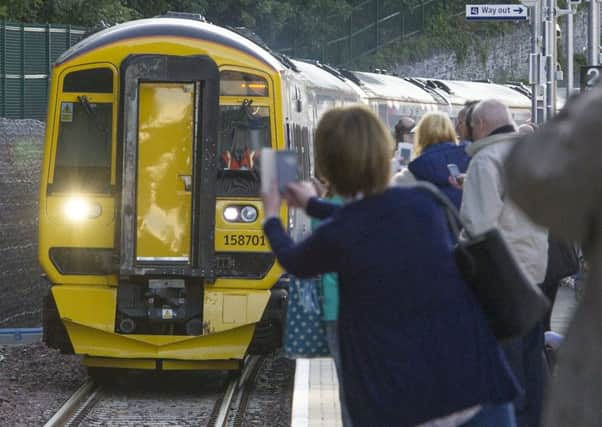David Spaven: Quango manages to derail Borders success story


So, what lessons can we learn from a year’s operation of trains from Edinburgh through Midlothian, climbing to the 880 ft high Falahill summit, then threading their way along the valley of the Gala Water to Galashiels and a terminus within sight of the majestic Eildon Hills?
First and foremost, the railway has proved to be extremely popular with both locals and visitors. Ironically, that popularity should be something of an embarrassment to Transport Scotland (the Scottish Government agency), whose unbelievably pessimistic forecasts three years ago suggested that an average of just over two passengers would use each train at the two biggest stations, Galashiels and Tweedbank. Over the first six months of operation, these forecasts proved to be underestimates of more than 400 per cent and 850 per cent respectively. Even allowing for the novelty factor of a new railway, that was shockingly wide of the mark.
Advertisement
Hide AdAdvertisement
Hide AdThe 241-space Tweedbank station car park is routinely full to overflowing, while at Galashiels, public transport users benefit from the impressive new transport interchange, where scheduled bus services fan out across the entire region. From Edinburgh to Gala, the train typically takes well under an hour, compared to 83-94 minutes on the bus along the A7.
The second lesson is that the largely single-track railway has been – predictably – plagued by unreliability due to inadequate infrastructure and the poorly-performing Class 158 trains. The proportion of “right-time” arrivals at Tweedbank has never reached 70 per cent across any one week since late last October, and across August, right-time trains at Edinburgh Waverley dropped to an average of below 30 per cent (as did Tweedbank arrivals).
That unreliability has had a particular impact on Midlothian stations, which have been the victim of skipped stops by late-running trains trying to catch up time. This practice has contributed to relatively poor patronage at three of the four stations in Midlothian, the exception being Newtongrange, where ready access to the Scottish Mining Museum has boosted numbers above forecast – demonstrating that while a degree of unreliability may be tolerable for the leisure market, it is increasingly unacceptable for daily commuters.
Third, the last year has shown that rail campaigners were right to point out – over many years – the limitations of the railway’s infrastructure specification. Based on the allegedly poor “business case” for the railway – caused in part by those utterly flawed patronage forecasts – Transport Scotland cut back the double-track requirement from 16 miles to just nine and a half miles. This, combined with long-standing and well-known track congestion on the East Coast Main Line between Edinburgh Waverley and Portobello Junction – and far too many track and signalling failures on the new Borders Railway itself – has bequeathed us a frequently unreliable train service.
Fortunately the political establishment did pay some heed to campaigners’ suggestions. The grassroots efforts of the Campaign for Borders Rail and Stow Station Supporters convinced the Scottish Parliament that this growing village should not be physically and economically by-passed by the new railway. Now Stow is seeing the benefit of increased visitor numbers, and the station – originally forecast officially to generate just five return rail trips per day – is seeing more than 75 return passengers daily.
The original feasibility study for the railway almost entirely dismissed tourist potential, but unpaid campaigners – who, unlike many of the expensively-recruited consultants, knew their Borders – argued long and hard for the platforms at Tweedbank to be extended to accommodate locomotive-hauled tourist charter trains. This has now been vindicated, with significantly increased visitor numbers at Sir Walter Scott’s nearby Abbotsford house. Leisure and tourist travel – along one of Scotland’s more scenic rail routes – is proving to be a key component of the new railway, with an increasing number of integrated train-bus day-out packages on offer from Edinburgh.
So, what has been the Transport Scotland reaction to this uneasy mix of good and bad outcomes? Three weeks ago, in response to a Scotland on Sunday report highlighting the line’s unreliability, including no fewer than 70 trains cancelled over the first ten days of August, the Scottish Government agency commented blandly that: “We are committed to ensuring ScotRail delivers a punctual and reliable rail service across the network and that they address issues around punctuality to give passengers the very best service possible.”
The ScotRail response – “As with other parts of the network, the Borders line is subject to occasional technical faults” – was even more complacent.
Advertisement
Hide AdAdvertisement
Hide AdAs a matter of urgency, before too many more commuters abandon the railway, Transport Scotland – who are the primary culprits – need to put together, in conjunction with Network Rail and ScotRail, an action plan to improve reliability over the inevitable years until any big infrastructure improvements can be delivered. (It remains to be seen whether a noticeable improvement in performance in the first week of September will be sustained.)
And MSPs should push for a short but incisive inquiry which will identify exactly why we ended up with such a sub-optimal railway specification, based on hopelessly inadequate patronage forecasts. The people of Midlothian and the Borders – and other parts of Scotland, like Levenmouth in Fife, which are campaigning for rail reinstatement – deserve no less.
• David Spaven is a campaigner, consultant and writer on railways. His book Waverley Route: the battle for the Borders Railway was published in 2015.